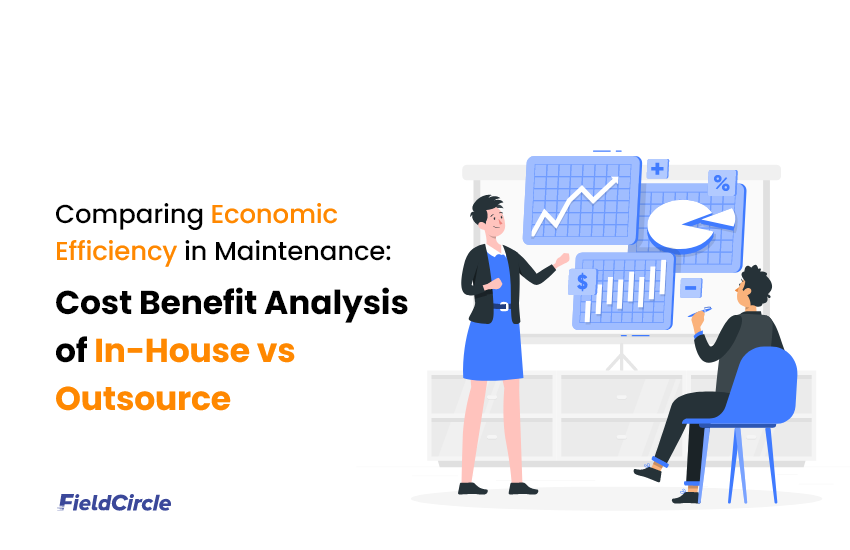Comparing Economic Efficiency in Maintenance: Cost Benefit Analysis of In-House vs Outsource

Postponing maintenance worth $1 could lead to a fourfold increase, resulting in $4 in capital renewal expenses.
So, the approach you choose for managing your maintenance operations will be the cornerstone of your financial success with maintenance.
Now, there are two options: First, you build your own in-house team of capable maintenance experts. Second – it’s simple – you choose to hire and seek the expertise of external maintenance professionals.
When conducting a cost-benefit analysis (CBA) for these options, one thing we must know is that maintenance processes vary across industries, and so do the associated costs. As a result, the intricacies of in-house versus outsourced maintenance require a tailored approach.
Recognizing the diversity of industries and their unique maintenance requirements, we arm you with generic frameworks for cost-benefit analysis for both of these options. Through them, we present a systematic process and empower you to make informed decisions on whether to manage maintenance in-house or opt for outsourcing.
Cost Benefit Analysis and Its Importance in Maintenance
By conducting a meticulous examination of the costs and benefits associated with both in-house and outsourced maintenance, this analysis seeks to equip decision-makers with the insights necessary for informed choices. The primary aim is to offer a clear understanding of the financial implications, operational advantages, and potential drawbacks inherent in each maintenance strategy.
Costs Associated with In-house Maintenance
Establishing and maintaining an in-house maintenance team involves a nuanced breakdown of costs, encompassing both direct and indirect expenditures.
Direct Costs
- Salaries: The most immediate and apparent expense is the salaries of maintenance personnel. This includes wages for technicians, engineers, supervisors, and any additional staff required for specialized tasks.
- Equipment: Acquiring and maintaining the necessary tools and equipment for maintenance tasks constitutes a significant direct cost. This includes the initial investment in machinery, regular maintenance of tools, and potential upgrades or replacements over time.
- Materials and Supplies: In-house maintenance requires a steady supply of materials such as spare parts, lubricants, and consumables. The cost of procuring and managing these materials is a direct expenditure that impacts budget considerations.
- Training: Continuous training is vital for an efficient in-house maintenance team. Costs associated with workshops, certifications, and skill development programs for employees contribute to the overall direct expenses.
Indirect Costs
- Overhead Expenses: These encompass the indirect costs associated with maintaining a physical workspace for the maintenance team, including rent, utilities, and general facility upkeep.
- Administrative Costs: Costs related to management, administration, and supervision of the maintenance team fall under this category. This includes salaries of supervisors, administrative staff, and any additional management-related expenses.
- Downtime Costs: Downtime is one of the important maintenance performance metrics. Unplanned downtime during maintenance activities can result in lost productivity and revenue. While not always easily quantifiable, the financial impact of downtime should be considered as an indirect cost.
- Insurance and Safety Compliance: Costs associated with insurance coverage for the maintenance team and adherence to safety regulations constitute indirect costs. This ensures compliance with industry standards and mitigates potential legal and financial risks.
Intangible Costs
- Management Overhead: Intangible costs associated with the time and effort invested by management in overseeing and coordinating in-house maintenance activities.
- Risk of Errors: Intangible costs related to the potential risk of errors or mistakes during maintenance tasks, impacting overall operational efficiency.
Possible Monetary Benefits of In-house Maintenance
- Reduced Outsourcing Fees: By handling maintenance tasks internally, businesses can optimize maintenance costs by avoiding the fees associated with outsourcing contracts. This approach can lead to significant cost savings over the long term, particularly for routine or predictable maintenance activities.
- Optimized Resource Utilization: In-house maintenance enables businesses to utilize existing resources more efficiently. Skilled staff can be cross-trained for various maintenance tasks, reducing the need for specialized external services.
- Investment in Long-Term Assets: Rather than allocating funds to external service providers, businesses can invest in building an internal team of skilled professionals. This long-term investment can lead to a self-sufficient and capable maintenance department, contributing to the organization’s overall resilience.
- Flexible Scheduling: In-house maintenance allows businesses to have greater control over scheduling and prioritizing tasks. This flexibility can lead to optimized workflow management, minimizing downtime and maximizing operational efficiency.
- Improved Quality Control: Direct oversight of maintenance activities allows businesses to maintain high-quality standards. In-house teams can quickly address issues and ensure that maintenance tasks are performed to the desired specifications, reducing the risk of errors.
Costs Associated with Outsourced Maintenance
Direct Costs
- Service Contract Fees: You will have to pay the fees to the external maintenance service provider as per the terms of the service contract.
- Materials and Parts Costs: These are expenses for materials, spare parts, and consumables used by the external maintenance service provider.
- Specialized Equipment Costs: These costs are related to the use of specialized tools and equipment by the outsourced maintenance team.
- Travel and Accommodation Expenses: You will incur expenses for the travel and accommodation of external maintenance personnel for their planned/unplanned on-site visits.
Indirect Costs
- Administrative Overhead: These costs are associated with the internal administrative efforts in coordinating with the external service provider, managing contracts, and overseeing the relationship.
- Communication Costs: Communication tools, software, and technologies used for collaboration between the business and the outsourced maintenance provider will result in some expenses.
- Downtime Costs: These are the costs caused by potential downtime during maintenance activities, which will impact productivity and potentially lead to revenue losses.
- Quality Control Oversight: Time and resources spent on monitoring and ensuring the quality of work performed by the external maintenance provider will bring some costs.
Intangible Costs
- Loss of Control: These are related to a potential loss of control over the maintenance process, as external providers operate independently.
- Cost caused by Dependency Risks: These are related to the risk of dependency on the external provider, which may pose challenges if the provider experiences issues or delays.
Possible Monetary Benefits of Outsourced Maintenance
- Reduced Labor Costs: External maintenance providers assume the responsibility of staffing and training, reducing the burden of labor costs on businesses. In another way, you don’t have to hire external talent, which leads to significant savings compared to maintaining an in-house team.
- Economies of Scale: Maintenance service providers can achieve economies of scale by serving multiple clients. This allows businesses to benefit from cost efficiencies in materials, equipment, and labor that may not be achievable on a smaller scale.
- Reduced Equipment and Tool Costs: Businesses outsourcing maintenance can avoid the upfront investment and ongoing costs associated with purchasing and maintaining specialized tools and equipment.
- Elimination of Training Costs: External providers are responsible for training their staff. This eliminates the need for businesses to invest in training programs, workshops, and certifications for maintenance personnel.
- Resource Allocation Flexibility: Outsourcing allows businesses to allocate resources more flexibly, focusing on core competencies while relying on external experts for specialized maintenance tasks. This flexibility enhances overall operational efficiency.
- Mitigation of Risk: External maintenance providers often assume certain risks, such as equipment failure or accidents during maintenance tasks. This can mitigate potential legal and financial risks for the business.
- Reduced Administrative Overhead: Outsourced maintenance minimizes administrative tasks related to managing an in-house team, resulting in reduced overhead costs for activities such as recruitment, payroll, and human resources.
Cost-Benefit Analysis for In-House Maintenance Management
We use the cost elements and perceived benefits discussed above with illustrative amounts to demonstrate how you can carry out the CBA for in-house maintenance management. This is a generic framework to which you can add costs and benefits as you may experience in your business.
| Category | Cost Element | Probable Investment ($) |
| Direct Costs | Salaries | 250,000 |
| Equipment | 100,000 | |
| Materials and Supplies | 20,000 | |
| Training | 15,000 | |
| Indirect Costs | Overhead Expenses | 50,000 |
| Administrative Costs | 40,000 | |
| Downtime Costs | 60,000 | |
| Insurance and Safety Compliance | 15,000 | |
| Intangible Costs | Management Overhead | 20,000 |
| Total Cost | 570,000 | |
| Benefit | Potential Savings |
| Reduced Outsourcing Fees | 300,000 |
| Optimized Resource Utilization | 40,000 |
| Investment in Long-Term Assets | 250,000 |
| Flexible Scheduling | 10,000 |
| Improved Quality Control | 10,000 |
| Risk Mitigation | 20,000 |
| Total Savings | 630,000 |
Net Savings in in-house Maintenance Management
= $630,000 – $570,000
= $60,000
Benefit-Cost Ratio = 1.105
Cost-Benefit Analysis for Outsourced Maintenance Management
Here is an illustrative break-up of various cost elements for the outsourced option along with probable annual investment figures. Based on the nature of your maintenance operations this cost framework may change. It’s difficult to quantify the intangible costs in this case, so we have not included them. However, you must carefully observe each intangible cost element and record the cost, if incurred, on account of it.
| Category | Cost Element | Probable Investment ($) |
| Direct Costs | Service Contract Fees | 50,000 |
| Materials and Parts Costs | 20,000 | |
| Specialized Equipment Costs | 100,000 | |
| Travel and Accommodation Expenses | 10,000 | |
| Indirect Costs | Administrative Overhead | 30,000 |
| Communication Costs | 8,000 | |
| Downtime Costs | 40,000 | |
| Quality Control Oversight | 12,000 | |
| Total Cost | 270,000 | |
| Benefit | Potential Savings ($) |
| Savings from Staffing | 250,000 |
| Cost Efficiencies from Scale | 50,000 |
| Avoided Equipment and Tool Costs | 20,000 |
| Savings from External Training Responsibility | 15,000 |
| Operational Efficiency Gains | 20,000 |
| Risk Mitigation Savings | 20,000 |
| Overhead Reduction | 25,000 |
| Total Savings | 400,000 |
Net Savings in Outsourced Maintenance Management
= $400,000– $270,000
= $130,000
Benefit-Cost Ratio = 1.48
What to Keep in Mind When Doing Cost-Benefit Analysis for Your Maintenance Operations?
Irrespective of the option you choose, there are some factors that will influence the result of your CBA. Though not each of them may apply in a given case, you must be careful enough to include or exclude them. These factors are:
- Accuracy: Ensure precise tracking of maintenance costs and benefits to avoid undervaluing or overestimating the overall value of maintenance efforts.
- Volatility of Cash: Acknowledge that maintenance costs can vary, making it important to factor in unexpected repairs or changes when conducting cost-benefit analyses.
- Impact of Income: Consider the financial capacity of the organization when deciding on the scope and type of maintenance activities.
- Intuition: Base maintenance decisions on thorough research rather than intuition, ensuring that data on costs and benefits are well-documented and reliable.
- Subjectivity in Value Assessment: Acknowledge that the value of certain maintenance activities can be subjective and may vary among stakeholders, requiring consideration of diverse perspectives.
- Non-Monetary Benefits: Recognize and account for non-monetary benefits, such as safety improvements or enhanced reputation, in addition to financial considerations.
- Duplication in Measurement: Exercise caution to prevent double-counting of benefits or costs when measuring maintenance projects in multiple ways, ensuring consistency for reliable results.
Drawing the Inference
With the results of CBA for both options at your disposal, you might find that outsourcing your maintenance operations is turning out to be more beneficial. But as we mentioned those were just illustrations to guide you.
Regarding your business context, you must meticulously capture each cost element and the benefits that both options can offer and then arrive at a decision. The ready-to-use frameworks we provide will come in handy in this process, reducing your efforts and time.

